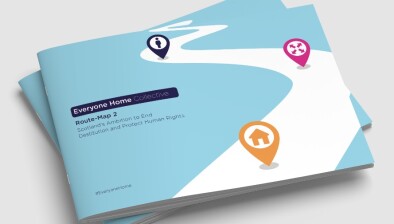Blog: The return of the Bedroom Tax monster?
 In a guest blog for the Scottish Council for Voluntary Organisations (SCVO), Shelter Scotland’s Aoife Deery says there are big questions regarding the future affordability of social housing.
In a guest blog for the Scottish Council for Voluntary Organisations (SCVO), Shelter Scotland’s Aoife Deery says there are big questions regarding the future affordability of social housing.
Four years ago, when the first wave of welfare cuts was breaking, Shelter Scotland ran a high profile campaign to Banish the Bedroom Tax Monster. The latest wave that is fast approaching is the Local Housing Allowance (LHA) cap. Labelled by some as the “Bedroom Tax 2”, it is one of the more complicated areas of welfare policy in recent times to detangle. The ramifications of a seemingly simple change to the way housing benefit is calculated could have far reaching impacts on social sector housing, and Scotland’s homelessness response.
In brief, the LHA cap will mean that social sector tenants who started their tenancy on or after April 2016 will only receive housing benefit at the level of the relevant LHA, rather than at the full cost of their rent. Social sector tenants who receive housing costs under Universal Credit will have the housing cost element capped at LHA level regardless of when they started their tenancy.
What does this mean for social housing and the people who depend on it for affordable homes? At first glance, you could be forgiven for thinking not much. On the whole, social sector rents are lower across the board than their private sector equivalents (on which LHA is based). Comparing, for example, average local authority (LA) and registered social landlord (RSL) rents (using data from the Scottish Housing Regulator) to the applicable LHA rate for different households shows that:
Superficially it appears that only the single person under 35 living in a one bedroom RSL will face a shortfall of less than £2 per week. But, averages like these create a false sense of comfort. In fact, rent levels and LHA levels vary considerably across council areas. Temporary accommodation will also be subject to change, and only the applicable LHA rate plus a management fee of £45 will be payable to cover temporary accommodation costs which can be as much as 282% above the area LHA rate. Significant concerns remain about how temporary accommodation can feasibly continue to be delivered with this shortfall in mind. In a nutshell, we predict (along with other professionals in the sector) that arrears both in permanent and temporary accommodation will rise sharply.
So why is it being referred to as the Bedroom Tax 2? The key point is that unlike housing benefit, LHA is calculated based on household size, and not the number of bedrooms in the house that is allocated. Extending LHA rates to social tenancies will not guarantee that the rent that has been set by the social landlord will be paid by housing benefit if there is a mismatch in household size to property. In effect, a single person household in a two bedroom property, or a family of three in a three bedroom property will have to top up their benefit payment for under-occupying their home.
This will create a huge problem for social landlords, both in terms of collecting the shortfall in rent from existing tenants, and in terms of allocating homes that households can afford. With this in mind, and to reflect the thoughts of GWSF’s David Bookbinder, are offers of housing made to tenants knowing they cannot afford the rent now unreasonable, even knowing that there are limited other options for these households?
In the short term, organisations such as the SFHA have done valuable work in beginning to estimate numbers of people who will be affected by the LHA cap, however a significant amount of research remains to be done to fully understand the impact.
In the longer term, Bedroom Tax 2 leaves some big questions for us to answer about the future affordability of social housing, particularly for young single homeless households – the exact group that ending priority need in Scotland benefitted the most. The social housing sector and the Scottish Government now must urgently address how to protect Scotland from the reappearance of the Bedroom Tax Monster.







